

Original Article - Year 2014 - Volume 29 -
Epidemiological study of patients hospitalized in the burn care unit of the Vila Penteado General Hospital - São Paulo
Estudo epidemiológico de pacientes internados na unidade de tratamento de queimados do Hospital Geral de Vila Penteado - São Paulo
ABSTRACT
INTRODUCTION: Burns are injuries with major morbidity and mortality and are a considerable burden on the government. The aim of this study was to investigate the epidemiological profile of patients admitted to the burn care unit (BCU) of the Vila Penteado General Hospital (HGVP/SP).
METHOD: The data analyzed were derived from patient admissions to the BCU of the HGVP, from January 2012 to July 2013, using the following variables: sex, age, cause and extent of the burn, time between burn/admission, length of stay, and patient's progress.
RESULTS: The majority of admissions were observed in men (65.8%). There was a greater percentage of burn patients in the adult population (80%). Fire was the main cause of injury (58.5%), followed by scalding (19.5%); 62% of burns occurred at home and 11.5% at work. Most victims (56.1%) had medium and large burns, and 46.3% of the patients were admitted in the first 24 hours after a burn. A length of stay of less than 15 days was most common (55.4%). The hospital discharge rate was 83% with a death rate of 17%.
CONCLUSION: This study demonstrated that the epidemiological profile for burns and admissions to the BCU of the HGVP was consistent with the great majority of data from other specialty centers, and emphasizes the importance of epidemiological studies on prevention.
Keywords: Burns; Epidemiology; Burn Unit.
RESUMO
INTRODUÇÃO: As queimaduras são lesões de grande morbidade e mortalidade que geram considerável ônus para o estado. Este estudo tem como objetivo traçar o perfil epidemiológico dos pacientes internados na Unidade de Tratamento de Queimados (UTQ) do Hospital Geral de Vila Penteado (HGVP/SP).
MÉTODO: Foram analisados os dados de internações de pacientes na UTQ do HGVP, no período de Janeiro/2012 a Julho/2013, sendo avaliadas as seguintes variáveis: gênero, idade, causa e extensão da queimadura, intervalo entre queimadura/internação, tempo de internação e evolução do paciente.
RESULTADOS: Observou-se predominância das internações em homens (65,8%). Em relação à idade, houve maior concentração de queimados na população adulta (80%). O fogo foi a principal causa de lesões (58,5%), seguido pela escaldadura (19,5%); 62% das queimaduras ocorreram no domicílio e 11,5%, no trabalho. Constatou-se que a maioria das vítimas (56,1%) apresentaram queimaduras de médio e grande porte e que 46,3% dos pacientes foram admitidos nas primeiras 24 horas pós-queimaduras. Quanto ao tempo de internação, foram verificados períodos inferiores a 15 dias como sendo os de maior incidência (55,4%). Obteve-se uma taxa de altas hospitalares igual a 83%, contra uma taxa de óbitos de 17%.
CONCLUSÃO: Este estudo demonstrou o perfil de queimaduras e internações na UTQ do HGVP compatível com a grande maioria dos dados de outros centros especializados, ressaltando a importância dos estudos epidemiológicos que visam à prevenção desse problema.
Palavras-chave: Queimaduras; Epidemiologia; Unidade de Queimados.
A burn is severe trauma with social, economic, and public health impact. It demands the attention of governmental agencies and is among the leading causes of morbidity and mortality. It is a highly complex trauma that is difficult to treat, requiring multidisciplinary care.
Even when burns do not lead to death, these serious injuries result in physical suffering, and require long-term treatment for months or years. Victims may have sequelae, resulting in psychological trauma.
The costs of treating burn victims go beyond those relating to care during the acute phase. Extended hospital stays and functional rehabilitation programs, often unaffordable for the victim, unquestionably burden the health system. On analysis of the social significance, burns, as well as other causes of trauma, afflict people in productive age groups, who are often the only source of income in the family.
The importance of preventing burns is due not only to how often these injuries occur, but also mainly to the resulting functional, esthetic, and psychological sequelae, and even death. With the current availability of excellent care, patients with severe burns survive; however, a new issue has emerged: the quality of life of these individuals.
Surveys conducted using the scientific databases LILACS and MEDLINE show a lack of epidemiological studies on the Brazilian population, with concentration on a few centers specialized in the treatment of this type of trauma, and based on international data.
It is of utmost importance, in all areas of medical expertise, to gain knowledge of the epidemiology, which provides support for the assessment and organization of treatment programs and prevention campaigns. The methodology for preventive activities can be improved upon with specific strategies by focusing on public health education. Conducting a greater number of national scientific and technical studies on the epidemiology of burns is necessary and desirable; research in tertiary institutions will form a basis for the development of effective prevention methods in the local population under study.
Studying the epidemiological profile of patients in burn care units is necessary to understand the main mechanisms of the trauma; accordingly, measures can be developed to reduce the number of events and tailor care in quantitative and qualitative terms. This contributes to the development of standards to ensure the quality of care in this population.
OBJECTIVE
The purpose of this study was to create an epidemiological profile of the patients admitted to the burn care unit (BCU) of the Vila Penteado General Hospital in São Paulo, Brazil (HGVP/SP). The addition of specific characteristics enables improvement of service and promotes future population educational policies with the goal of preventing burns.
METHOD
All patients admitted to the BCU of the HGVP/SP were evaluated from January 2012 to July 2013 and logged into the admissions control records of the unit. In addition, data obtained from the medical records system (SAME) were logged, resulting in a total of 164 patients, making this a retrospective, observational, and descriptive study.
This study included only patients who required hospitalization beyond initial care. Less severe cases managed as outpatients were excluded.
In this study, age, sex, cause of burn, extent of burn, time between the burn and admission, length of stay, patient progress during hospitalization, and other relevant variables were considered.
The following age strata were used: 0-12 years (children), 13-18 years (adolescents), 19-60 years (adults); and >60 years (elderly).
The following causal agents were verified: fire, scalding by hot liquids, electricity, chemicals, and contact injuries. These data were correlated with sex, the preset age groups, and the place where the event occurred. The latter included the home, outside the home (except workplace), workplace, or unknown (location was not provided).
The extent of the burn was based on the body surface area (BSA) affected. Second- and third-degree burns were thus divided into three categories: (1) up to 10% of BSA affected (small burn), (2) 11-25% (medium burn), and (3) greater than 25%, (large burn).
The time interval between the burn and the admission was divided into five groups: (1) up to 24 hours; (2) 24-48 hours, (3) 48-72 hours, (4) 72 hours to 7 days, and (5) more than 7 days.
Length of stay was divided into three groups: (1) 0-15 days, (2) 16-30 days, and (3) more than 30 days.
Patient progress during hospitalization was divided between discharge and death.
The project was submitted to the Research Ethics Committee of the HGVP/SP, under protocol number 25340013.2.0000.5446, on December 13, 2013.
RESULTS
Hospitalized males predominated (65.8%) in comparison to females (34.2%), in a ratio of 1.92:1. These data were corroborated by other studies (Figure 1)1,3,6.
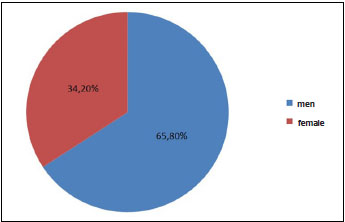
Figure 1 . Distribution of burned according to gender .
There was a higher rate of burns in the 19-60 years age group (80.0%). (Figure 2).
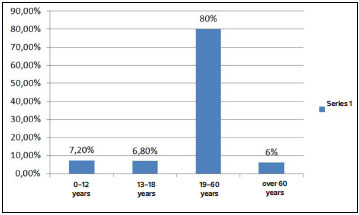
Figure 2 . Distribution of patients with burns according to age .
Most of the injuries were caused by fire (58.5%), followed by scalding with hot liquids (19.5%). Other data pertaining to the etiology of the burns and their correlation with patient age are described in detail in Figure 3 and Table 1, respectively.
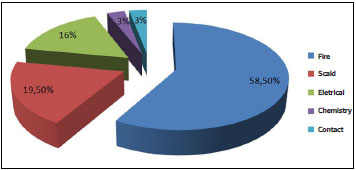
Figure 3. Distribution of etioológicos agents.
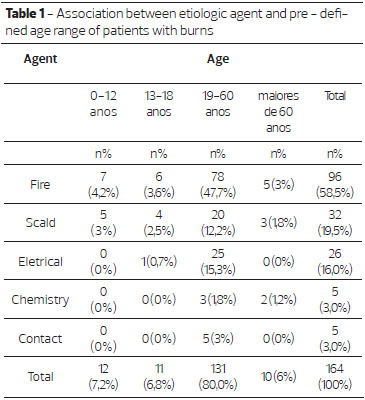
Most of the events occurred in the home environment (62%) as shown in Figure 4.
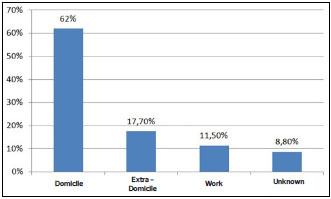
Figure 4. Location of the event.
Nearly half of the patients were admitted within the first 24 hours after the burn (Figure 5), and received appropriate and specific care during the period considered critical in this type of trauma.
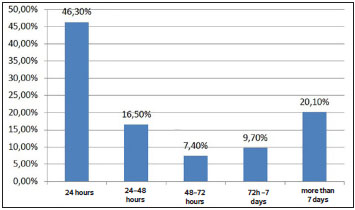
Figure 5. Percentage of patients in relation to the burn - admission interval .
It was observed that 43.9% of the victims presented small burns, affecting up to 10% of their body surface; 36.6% of the patients showed medium-size burns, affecting 11%-25% of their body surface; and 19.5% of the patients showed large burns, affecting over 25% of their body surface.
A length of stay of less than 15 days was most common (57.4%) (Table 2), with the average duration of hospitalization being approximately 18 days.
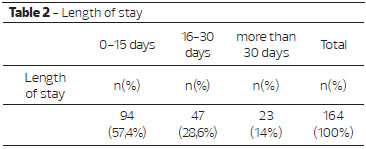
The hospital discharge rate was 83%, with a death rate of 17%. Among the 28 deaths, the main etiology was fire (78.6% of deaths); the vast majority of the patients who died (67.8% of cases) presented with a burned BSA greater than 25%, and were therefore considered patients with large burns.
DISCUSSION
Every patient seen in the BCU of the HGVP/SP is logged into the unit's own record book, with data including the name, file number, sex, age, burn etiology, victim's origin, percentage of BSA burned, degree of burn, hospital record, date of admission, and discharge or death. This book was used to identify patients and select the charts of interest to the study.
Burns represent an important cause of injuries, and are both life threatening and a source of important functional and esthetic sequelae in survivors. Burns generally afflict otherwise healthy people, and result in losses through occupational absenteeism, given the prevalence among young, economically active adults.
Commonplace situations and readily obtainable combustible agents are part of the problem; these should be addressed with greater urgency by the authorities, with health education and prevention policies brought to the forefront.
The data were generally consistent with other national and international studies regarding the prevalence of burns among males1,3,6, with fire as the main causative agent1,4,8,10. Men still predominantly perform tasks involving greater risk of accidents, such as handling mechanical equipment, working on the power grid, and handling chemicals and fuel. There are also other risks, such as automobile accidents. In the pediatric age group (0-12 years), fire was also the predominant etiology; this differed from other studies2,11,12, in which scalding was considered the primary etiology in children. Such differences may be attributable to the smaller number of children admitted to the BCU (12 cases, 7.2% of patients). Most cases occurred within the economically active population (19-60 y), reinforcing the economic impact of such trauma. The burn events were found to predominantly occur at the patient's residence1,2,7,8,10,12, suggesting carelessness and lack of safety in the home environment. The sizable percentage of accidents in the workplace (11.5%) emphasizes the need for investment in protective equipment and encouragement of its use.
There was a predominance of patients with lesions over a BSA of 11-25% (36.1% of cases) and BSA greater than 25% (19.5% of cases), accounting for 55.6% of the hospitalizations. These data differ from those of some other centers5,11, where there was a predominance of patients admitted with small burns.
The average duration of stay was 18 days. This value was comparable to that reported by previous studies12,13. Adequate human and technological resources, strict use of evidence-based technical protocols, early surgical intervention, and aggressive nutritional support tend to decrease the length of stay, as well as morbidity and mortality rates, of burn patients.
This study showed a death rate of 17% (28 cases) during the period evaluated, which differs from the results of other studies,9,14 in which a lower mortality rate was observed. We believe that this difference may be due to the high number of patients admitted to the BCU with large burns, affecting over 25% of their body surface. 67.8% of the deaths (19 cases) were from these patients.Advances in burn care have reduced mortality and improved quality of life; however, the ways in which accidents occur, including their etiological factors, are scenarios that repeat themselves on a daily basis in our home and work environments.
Understanding the epidemiological profile of burn patients is important for identifying groups at risk; this enables organization of preventive campaigns to reduce the magnitude of this type of trauma. This, in turn, would change the epidemiological profile of burn patients, especially with respect to the severity of the injuries.
In light of the findings from this study, there is a need for policies relating to greater control of liquid combustible agents, and better safety education at home and work.
CONCLUSION
This study showed that the profile of burns and hospitalizations at the BCU of the HGVP/SP was consistent with the great majority of data in profiles described by other centers specializing in this type of care.
The importance of continuing population education is emphasized as a means of preventing accidents due to reckless household activities related to child care and handling of flammable products and negligence in the use of personal protective equipment at work.
These areas of study are of utmost importance in the understanding of and design interventions for risk factors and behaviors, leading to adoption of public preventive, educational, and regulatory policies.
REFERENCES
1. Kliemann JD. Estudo epidemiológico dos adultos internados por queimaduras no Hospital de Pronto Socorro (HPS-PA). Ver HPS. 1990;36(1):32-6.
2. Rossi LA, Barruffini RC, Garcia TR, Chianca TC. Burns: characteristics of cases treated in a teaching hospital in Ribeirão Preto, SP, Brazil. Rev Panam Salud Publica. 1998;4(6):401-4.
3. Bessa DF, Ribeiro AL, Barros SE, Mendonça MC, Bessa IF, Alves MA, et al. Perfil epidemiológico dos pacientes queimados no Hospital Regional de Urgência e Emergência de Campina Grande, PB, Brasil. Rev Bras Ciencia Saúde. 2006;10(1):73-80.
4. Remón W, López J, González C, Del Giorno A, Marcias Aura. Queimaduras: epidemiologia y casuística Del Hospital Industrial de San Tomé. Rev Venez Cir. 2001;54(2):77-82
5. Song C, Chua A. Epidemiology of burn injuries in Singapore from 1997 to 2003. Burns. 2005;31(Suuppl 1):S18-26.
6. Greco Jr. JB, Moscozo MVA, Lopes Filho AL, Menezes CMGG, Tavares FMO, Oliveira GM, et al. Tratamento de pacientes queimados internados em hospital geral. Ver Soc Bras Cir Plást. 2007;22(4):228-32.
7. Hemenda M, Maher A, Mabrouk A. Epidemiology of Burns admited to Ain Shams University Burns Unit, Cairo, Egypt. Burns. 2003;29(4):353-8.
8. Costa DM, Abrantes MM, Lamounier JA, Lemos AT. Estudo descritivo de queimaduras em crianças e adolescentes. J pediatra. (rio J.)1999;75(3);181-6.
9. Carvalho GG, Freitas FC, Macedo JL. Estudos prospectivos das vítimas de queimaduras atendidas no serviço de emergências do Hospital Regional da Asa Norte de Brasília, 1992-1997. Brasília Méd. 2000;37(3/4):87-92.
10, Rivera MG. Estudo anual prospectivo de las quemaduras infantiles em una área de La Región Metrpolitana. Pediatr Dia. 2001;17(5):349-53.
11. Kliemann JD, Lehugeur DS, Franche GL, Seara SC. Avidentes por queimaduras em crianças: estudo epidemiológico. Ver HPS. 1990;36(1):36-41.
12. Celco AM, Grivna M, Donava J, Barss P. Severe childhood Burns in the Czech Republic: risk factors and prevention. Bull World Health Organ. 2009;87(5).374-81
13. Burton KR, Sharma VK, Hroop R, Lindsay R. A population-based study of the epidemiology of acute adult burn injuries in the Calgary Health Region and factors associated with mortality and hospital length of stay from 1995 to 2004. Burns. 2009;35(4):572-9.
14. Santana VB. Perfil epidemiológico de crianças vítimas de queimaduras no município de Niterói-RJ. Rev Bras Queimaduras. 2010;9(4):130-135.
1 - General Surgeon - Plastic Surgery Resident (R3) at the Vila Penteado General Hospital, São Paulo, Brazil
2 - Collaborating Prof. Dr. of Plastic Surgery at Unifesp - Thesis Advisor Prof. of the Plastic Surgery Graduate Program at Unifesp, Plastic Surgery Residency Program Preceptor of the Vila Penteado General Hospital, São Paulo, Brazil
3 - General Surgeon - Plastic Surgery Resident (R2) at the Vila Penteado General Hospital, São Paulo, Brazil
4 - General Surgeon - Plastic Surgery Resident (R1) at the Vila Penteado General Hospital, São Paulo, Brazil
Institution: Work performed at the Vila Penteado General Hospital, São Paulo, SP, Brazil.
Corresponding author:
Eric Pimentel de Castro Leitão
Avenida Ministro Petrônio Portela, 1901, Apartamento 191, Bloco A- Vila Amélia
São Paulo, SP, Brasil - CEP: 02802-120
Telefone: (11) 999911801
Email: ericpcl@ig.com.br
Article received: December 11, 2013
Article accepted: March 4, 2014


 Read in Portuguese
Read in Portuguese
 Read in English
Read in English
 PDF PT
PDF PT
 Print
Print
 Send this article by email
Send this article by email
 How to Cite
How to Cite
 Mendeley
Mendeley
 Pocket
Pocket
 Twitter
Twitter